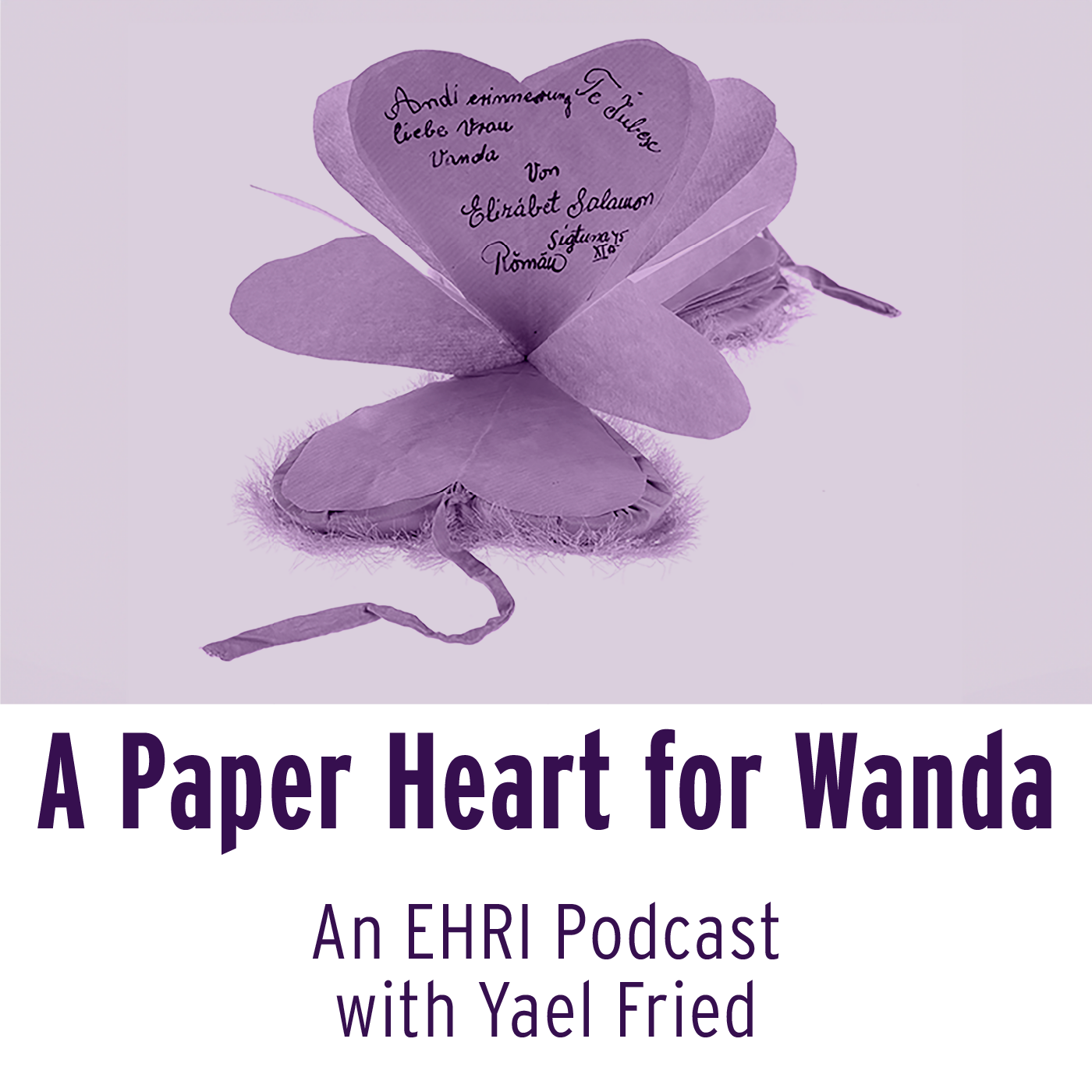
Release date: 30 November 2023 | More about the Podcast Series For the Living and the Dead. Traces of the Holocaust
In this podcast episode, the object of our attention is a delicate paper heart, a small work of art, crafted by Elisabeth Salomon. You can enfold the 'heart', like a flower, and on each petal, you will find the name of the woman or girl (sometimes a boy or man) who made it, maybe a date or place, and endearing messages of gratitude. Elisabeth was not the only woman who crafted this paper heart. There are many paper "hearts", all with their own uniqueness, in the Swedish Holocaust Museum, that was opened in the summer of 2023. Many carry a message on one of the petals that is more or less similar to the one by Elisabeth: "Andi erinnerung liebe Vrou Wanda", not so good German for "of/for the memory of dear Mrs Wanda".
Elisabeth Salomon, was Romanian and Jewish. Although from Romania, she spoke Hungarian and then used the names Erzsebet or Bözsi. We don't know much about her life until she was one of the prisoners of Bergen Belsen when the camp was liberated on 15 April 1945. Like all prisoners in the camp, Elisabeth (her name in Swedish/Romanian) was in a horrible condition, close to death.
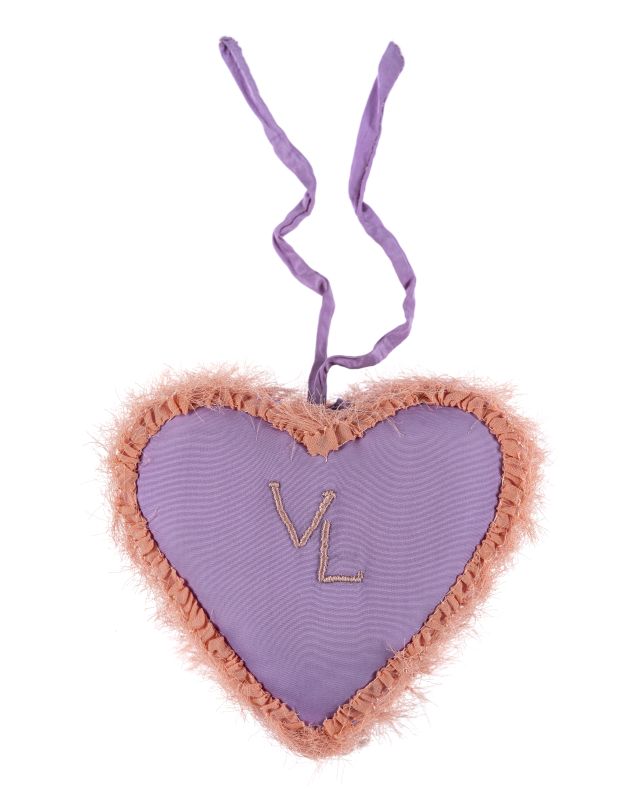
© National Historical Museums,
Sweden, Photographer:
Helena Bonnevier
In the summer of 1945, Sweden agreed to allow 10,000 ex-inmates of Belsen, Buchenwald and other German concentration camps to travel to Sweden and stay there for a period of six months recuperation. Elisabeth and a relative, possibly cousin, Laura, who also survived the camp, were brought on one of the so called White Boats to Sweden where they recovered in a hospital. It was here that they met Wanda Lanzer, an Austrian-Jewish woman who had sought and found refuge in neutral Sweden and was now involved in helping the survivors of the camps. Like many others, Elisabeth felt very grateful to Wanda and developed a special bond with her. She wrote to her also after her release from hospital and Wanda helped her with books and housing. After a while though, Elisabeth returned to Romania. We don’t know anything about her from then on.
The paper hearts are now part of the collection of the recently opened Swedish Holocaust Museum in Stockholm.
Featured guests:
Yael Fried is curator at the Sveriges Museum om Förintelsen, the Swedish Holocaust Museum. Podcast host is Kevania de Vries-Menig.
Yael will tell the story of Elisabeth Salomon and the paper heart she made for Wanda Lanzer. Listen to the episode on Buzzsprout, Spotify, Apple Podcasts, Google Podcasts or here:
Meine liebste Frau Wanda,
Ich bin Gott sei Dank angekomen, auf einem wunderschönen Platz angekommen. Es sind kleine Zimer, ich wohne wieder mit Laura, mit noch einem Mädchen. Wir haben alles, was es sein muss alles ist bequem und gut.
Liebe Frau Wanda, ich bin doch traurig dass ich musste meine liebe Wohltäterin die ich und so serh liebe und fühle dass sie liebt mich auch dort lassen.
(...)
Translation
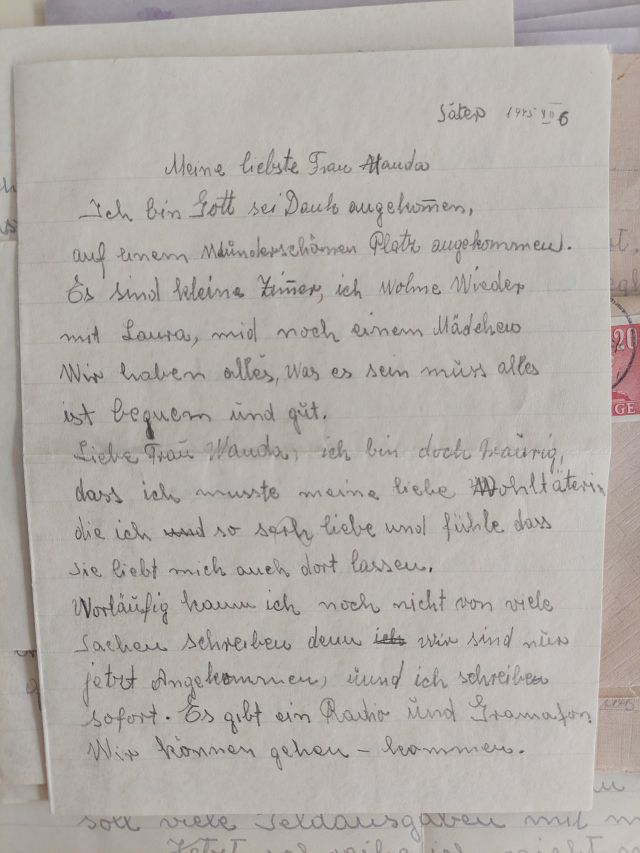
Photographer: Helena Bonnevier
My dearest Miss Wanda,
I have arrived, thank God, in a beautiful place. They are small rooms, I live with Laura again, with another girl. We have everything we need, everything is comfortable and good.
Dear Miss Wanda, I am sad that I had to leave my dear benefactor whom I love so much and feel that she loves me.
For the time being I cannot write about many things because we have only just arrived and I will write immediately. There is a radio and a gramophone. We can go - come without asking permission.
I would like to ask something. Maybe I could get some Hungarian books from dear Miss Wanda and also the one with poems. If it is not possible then I have not asked.
Please write me a lot, more next time.
I kiss the children and the Miss very much and my dear - dear Miss Wanda I kiss very - very much.
Bözsi
PS: I am learning German diligently.
Letter from Elisabeth Salomon to Wanda Lanzer, 6 July (?) 1945, in German and translation, including possible mistakes, Swedish Holocaust Museum.
This was one of the letters Elisabeth Salomon wrote to Wanda Lanzer after she had recovered in the hospital where the survivors of the Holocaust first received shelter. It was in the hospital she had met Wanda Lanzer, who had also helped her and Laura to find housing in Sweden to recuperate further. They also corresponded about books and Elisabeth tried to learn German, perhaps also to communicate easier, and asked for Hungarian. Initially, Sweden had consented to a period of six months recuperation for the refugees. Meanwhile UNRRA (the United Nations Relief and Rehabilitation Administration) would try to arrange the return to their home countries. In many cases, this never happened. Approximately half of the survivors (among them mostly Jews) stayed in Sweden, others went to the US or Israel or elsewhere. However, Elisabeth did return to Romania. Unfortunately, there is no trace of her after she left Sweden.
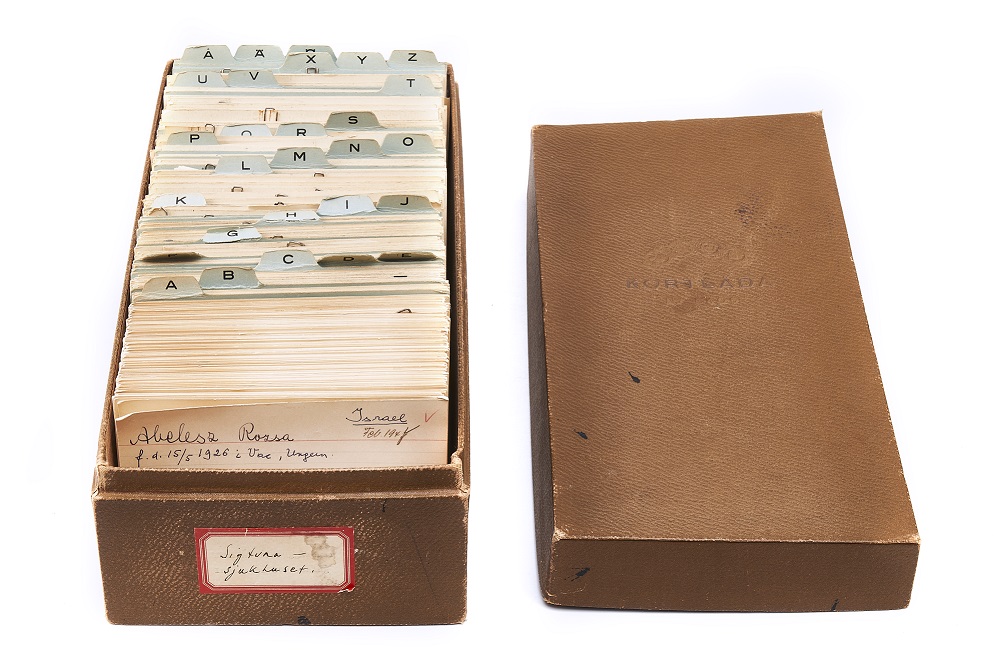
Photographer: Helena Bonnevier
Wanda Lanzer kept a card catalogue box with all the names of the people she helped, among them Elisabbeth and Laura. Many people made small gifts for Wanda, and for others of the nursing staff. Of Elisabeth, we have this letter to Wanda, a postcard, a letter from her relative Laura to Wanda, and this ‘paper heart’. Many people who were rescued, mostly the younger women, made these 'hearts', which are a bit like foldout boxes. In the boxes, they wrote their names, sometimes dates and expressions of gratitude. It is possible that this was also a way of reestablishing their sense of self, of their lost identities. Also in the camps, people tried to make or craft small objects with the littlest of means.
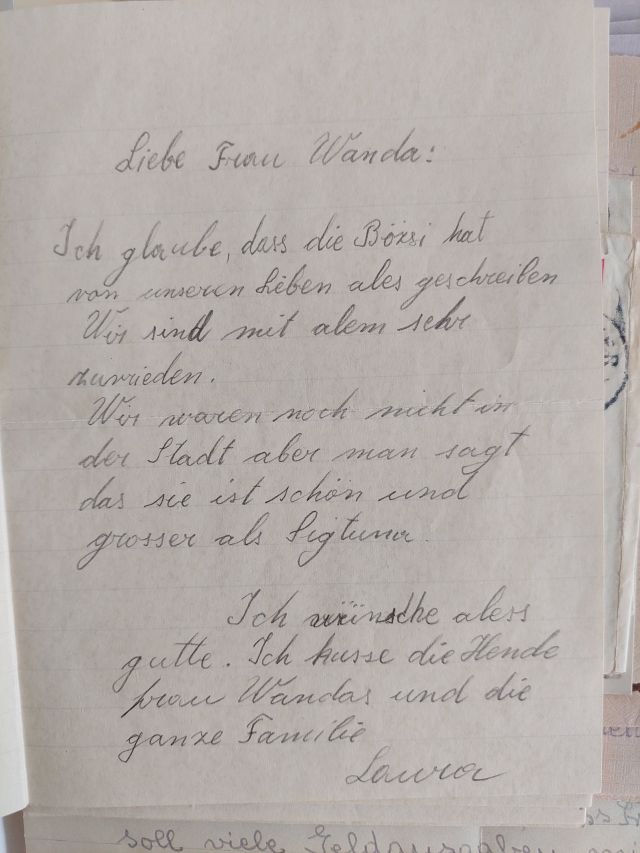
Sweden, Photographer:
Helena Bonnevier
Dear Miss Wanda,
I believe that Bössi has written everything about our life.
We are very happy with everything
We have not been to the city yet, but they say it is beautiful and bigger than Sigtumar (?).
I wish you all the best. I kiss the hands of Miss Wanda and the whole family.
Laura
Letter from Laura to Wanda Lanzer, date unknown, Swedish Holocaust Museum
Wanda Lanzer
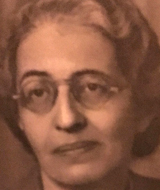
Unlike Elisabeth Salomon, of whom we know very little, Wanda Lanzer (née Landau) is quite well known, as an Austrian archivist, librarian and the "inventor of night school". Wanda Landau was born in 1896 in Vienna and received a doctorate in 1924 from Carl Grünberg at the University of Vienna on the "Marxist theories of crisis". From 1927 onwards, she worked for the Social Science Study Library of the Chamber of Labour, but was dismissed in 1934 for political reasons. After the Anschluss of Austria, Lanzer's apartment was searched and her husband, the lawyer Felix Lanzer, disappeared under mysterious circumstances. After the war, he was declared dead. With the help of Swedish Social Democrats, Lanzer and her daughters were able to flee to Sweden in the spring of 1939, where she was in close contact with other Austrian emigrants.
In Sweden she worked, among other things, for the town hall in Stockholm, and after 1945 as a supervisor and interpreter for rescued concentration camp prisoners. In 1949, she and other German speaking refugees were employed by the Stockholm Archives of the Labor Movement. Here she remained until her retirement in 1964. It was not until that year, that Lanzer returned to Vienna. There she died in 1980. Her urn was transferred back to Stockholm.
Sweden and WW2
In 1939, the Kingdom of Sweden, a parliamentary democracy, declared it would stay neutral in case of a war between the European powers. Germany’s conquest of Denmark and Norway in 1940, however, pulled Sweden into the Third Reich’s military sphere of influence. In this position, Sweden was no longer able to pursue its policy of “active neutrality”.
Before 1939, Sweden had a total population of about 6,326,000 people. Approximately 7,000 of them were Jews. 900 more arrived as refugees from occupied Norway, when the Norwegian collaborationist government prepared for the deportation of the country’s Jews in 1942. Access to Sweden was initially restricted, but faced with growing evidence of deportations and mass murder of the European Jews, the Swedish Foreign Ministry softened its stance on immigration. As a result, all Jews who fled to Sweden were granted asylum. In October 1943, after the Germans prepared to arrest of the Jews of Denmark, nearly all of Denmark's 8,000 Jews were brought to safety in Sweden. In early 1945, Sweden was able to secure the release of some Scandinavian and other concentration camp inmates. Overall, between 1933 and 1945, approximately 25,000 Jews immigrated to Sweden, mostly from Germany, Denmark or Norway. Sweden was therefore an exemption, being the only European country where the Jewish community actually grew during the wartime years.
White Boats and White Buses
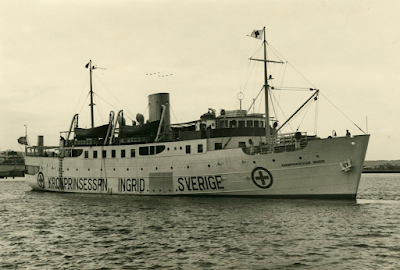
For one month in the summer of 1945, five Swedish ships, the UNRRA White Boats, evacuated more than 9,000 survivors from German concentration camps.. Most of them were women and children from the concentration camp Bergen-Belsen. They arrived at various ports in Sweden, were quarantined and then transferred to hospitals for treatment. After recuperation in a hospital, they were given help to repatriate to their home countries or were given the possibility to move from Sweden elsewhere in the world, also outside Europe. Some of them immigrated to Israel. However, a large group of people stayed in Sweden.
Much more well known than the White Boats, are the White Buses. The White Buses operation was carried out before the White Boats mission, in fact before the war was over. It was a Swedish humanitarian operation with the objective of freeing Scandinavians in German concentration camps in Nazi Germany during the final stages of World War II. Although the White Buses operation was created to rescue Scandinavians, one-half of those taken from the camps to Sweden were of other nationalities. The buses used to transport the prisoners were painted white with red crosses on the roof, side, front and back, so that the buses would not be mistaken for military targets by Allied air forces. Those allowed by the Germans to be freed from the concentration camps were transported by the white buses and trucks to the port city of Lübeck, Germany. Swedish ships took them onward to Malmö.
Swedish diplomat Folke Bernadotte and others negotiated the White Buses operation with German officials, especially Heinrich Himmler. The Swedish Red Cross estimated that about 15,345 prisoners from concentration camps were thus liberated in March and April 1945. 7,795 of them were Norwegian and Danish prisoners and 7,550 were of other nationalities. After the German capitulation on 8 May 1945, another 10,000 people were rescued in May and June 1945 by the "White Boats."
Yael Fried and the Sveriges Museum om Förintelsen, the Swedish Holocaust Museum
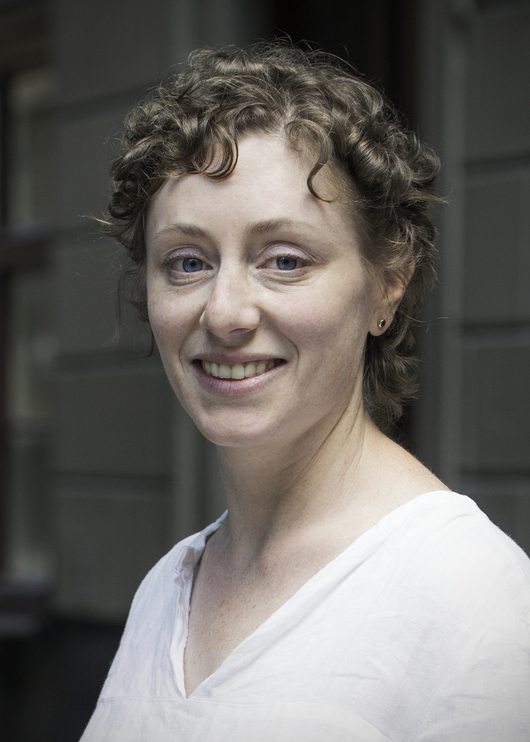
Courtesy of the Swedish Jewish Museum
Yael Fried was curator at the Swedish Jewish Museum before she became curator at the newly founded Swedish Holocaust Museum, where she currently works. She was actively involved in the foundation of the Holocaust Museum.
In 2021, the Swedish government decided to investigate and subsequently to establish a Swedish Holocaust Museum within the framework of National Historical Museums. They argued that the Holocaust is a defining event in European history, firstly for the millions who were persecuted and murdered, but also for postwar views on humanism and ethics. The establishment of the museum is an acknowledgement that, although not perpetrated on Swedish soil, the Holocaust is very much a part of Sweden’s history and cultural heritage. The museum was formally established in July 2022, but opened its gates in June 2023 with its first exhibition.
One vital point of departure for the museum is the stories of the survivors who came to Sweden. By exhibiting the stories and artefacts donated to the museum, it preserves and passes on the history of the Holocaust as it pertains to Sweden.
Learn More
- Wanda Lanzer on Wikipedia
- Wanda Lanzer on dasrotewien.at
- Sweden in the EHRI Portal
- The Swedish Holocaust Museum
- White Boats
- On the UNRRA operation in Swedish: Britta Zetterström Geschwind, Markus Idvall, Fredrik Nilsson, Den medicinska spärren: Smitta och gränsarbete i skuggan av Förintelsen (The medical barrier: Contagion and border work in the shadow of the Holocaust) (Göteborg 2023).
- Testimony by Manya Friedman, who was on a White Bus, on the website of the US Holocaust Memorial Museum
Credits
Our thanks go to:
- Yael Fried and the Swedish Holocaust Museum
- Halina Neujahr for the use of her testimony from the USC Shoah Foundation
- Esther Brunstein for the use of her testimony from the USC Shoah Foundation
- Music accreditation: Blue Dot Sessions. Tracks - Opening and closing: Stillness. Incidental, Gathering Stasis, Pencil Marks, Uncertain Ground, Marble Transit and Snowmelt. License Creative Commons Atttribution-NonCommercial 4.0 International (BB BY-NC 4.0).
- Andy Clark, Podcastmaker, Studio Lijn 14
